
Paris is a city filled with architectural landmarks - the Eifel Tower, the Arc de Triomphe, Notre Dame and many others. This is the Paris that all visitors know, but the city is also rich in architectural styles from a range of periods, including from 1900 - 1939, encompassing some fine art nouveau buildings and what survives of its art deco heritage.
This period is perhaps best exemplified through the built legacy of three architects. The best known of the three is Hector Guimard. Born in Lyon in 1867, Guimard is the central figure of French art nouveau. He studied at the Ecole Nationale de Beaux Arts in Paris where he was introduced to rationalist thought which led to his rejection of classicism in architecture and to his exploration of art nouveau.
He is perhaps best known for his metro station designs - more than 60 of which still survive today. The most well-known of these is the beautiful entrance to Des Abbesses in Montmartre (pictured above) with its curved lines, green metalwork and glass roof. This is not the original site of this structure - it was originally the entrance to Hotel de Ville metro station, but was relocated in 1970 to make way for a car park development (!). At least it was saved.
Guimard's period of designing metro stations ran from 1899-1904, but his legacy includes many more important Paris landmarks. His masterpiece (and my favourite) is the exquisitely indulgent Castel Beranger at 14 Rue La Fontaine in Auteuil, the 16th arrondissement. Built from 1897-98 in what was then the village of Auteuil, the Castel shocks with vibrant green, orange and blue metalwork, including its famous front gate (pictured below) with its asymmetrical sweeps and swirls. The facade which is a riot of materials and colours won the then prestigious City of Paris Facade competition in 1899.
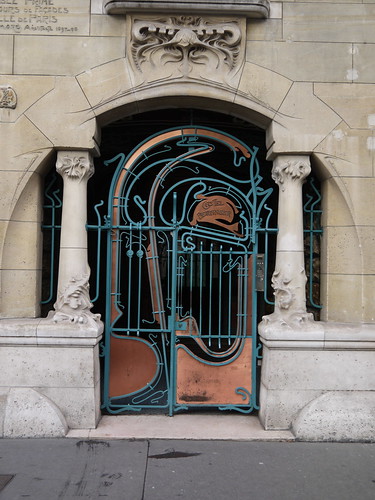
There are 36 apartments in the Castel and to get the full picture, walk into the small lane at the side of the building and see its depth and many different features. Materials used in the structure include glazed stoneware and ceramics, pale pink brick, wood, cast iron and steel. Unfortunately, Castel Beranger was not to everyone's liking and in some quarters became known as Castel Deranger - as in deranged! However, a number of leading cultural figures loved it and artist Paul Signac lived here for a time. Guimard followed the tradition of other European artists such as Joseph Hoffman, Adolf Loos and Victor Horta, also designing all of the interior features including wallpapers, door handles and carpets.
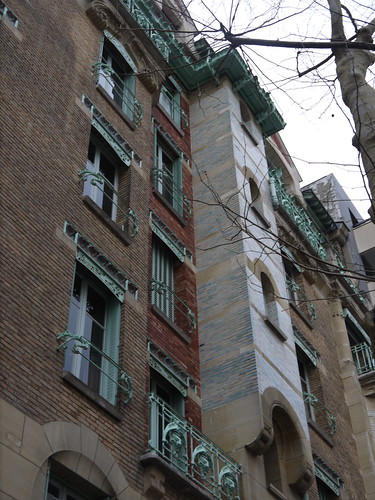
Across the road from Castel Beranger, at numbers 17-19 Rue La Fontaine, there are two more Guimard designed buildings dating from 1909-1911. The small alley at the rear of this block, Rue Agar also has a Guimard building at number 10. Numbers 17-19 are imposing corner buildings with heavy traffic on two sides and it is quite difficult to imagine what Auteuil must have been like when Guimard was at his productive peak. However, the ground floor of number 17 is home to Cafe Antoine (pictured below), a small but cosy place to stop off and sample their popular Dutch hot chocolate and to chat with the friendly staff who told me that the cafe was part of the original building so that residents could come downstairs take coffee or tea and talk to their neighbours. They also told me where I could see more Guimard buildings.
A photograph from 1911 is displayed in the cafe showing the building as it looked in its early days - and there is very little difference now. I particularly like the window features on this building, again with those art nouveau curves and metalwork "balcony" features with floral motifs.
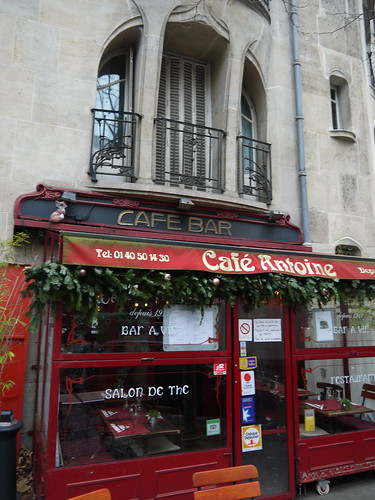
The 16th arrondissement is home to a number of Guimard's buildings. Further along Rue La Fontaine, at number 60, you can find Hotel Mezzara (pictured below), designed as a private residence for fabric manufacturer Paul Mezzara and built in 1910. The building now belongs to the Ministry for Education and holds occasional exhibitions to display the work of young artists. Whilst I was photographing this building, an elderly lady stopped and asked me if I knew about it - in French of course. My French runs out very quickly but she had some knowledge of English and explained to me about how beautiful the interior is, that Guimard was a great artist and that for this building too he designed the interiors including the door handles. She was clearly very proud of Guimard's legacy and told me where there were other buildings of his not too far away. A lovely lady and one of those chance encounters that can make travel so fulfilling.
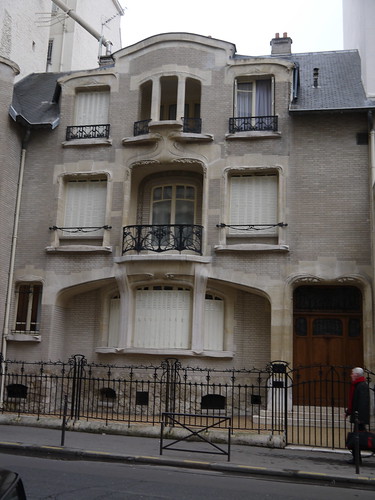
There are many more Guimard buildings in this part of the city, including two next door to each other at 120 (Villa Flore) and 122 (Villa Guimard) Avenue Mozart. He designed Hotel Guimard (pictured below) as a home for himself and his wife, artist Adeline Oppenheimer and construction was carried out from 1909-1913. His office was on the ground floor and Adeline's studio on the top floor with a north facing window to ensure good quality light to paint by. Built on an extremely narrow footprint, he designed everything for the house including the door lock and the interior furnishings. Adeline wished to leave the building to the city as a museum but shamefully this was not supported and the house is now divided into apartments. The interiors have been dispersed and later residents appear to have made "improvements" to the windows by ripping out the originals. Sinful.
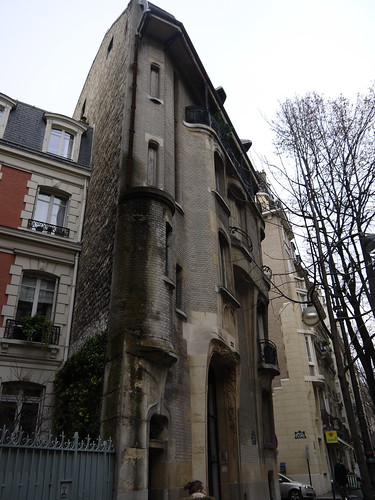
Villa Flore was designed for Michel Houyvet, a Parisian industrialist and was built between 1924 and 1927. It has a distinctive cladding on the front and side of the building with lighter coloured tiling providing a slightly more art deco feel to the design.
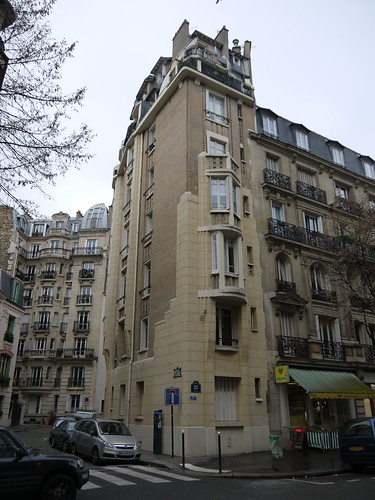
Interestingly and unusually, Guimard also designed the Agudas Hakehilos synagogue at 10 Rue Pavee in the fourth arrondissement (pictured below). The synagogue was constructed in 1913 and inaugurated on June7th 1914. Commissioned by the Agudas Hakehilos, or Union of Communities, an Orthodox Jewish society originating in Russia and headed by one Joseph Landau. The exterior features stylised vegetal decoration and is protected from the street by cast iron railings. It is the only religious building that Guimard designed. The occupying Germans dynamited the building on Yom Kippur eve in 1941 together with six other Parisian synagogues but it was subsequently restored and registered as an historical monument in June 1989.
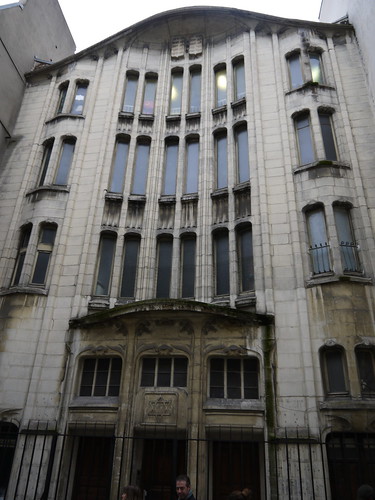
Few details are known about Guimard's personal life - there are no major collections of correspondence or other papers in the public domain. He married Adeline in 1909 and from then on concentrated his efforts on more domestic residences. In the period leading to the First World Ward, art nouveau declined in popularity and art deco took its place. Guimard remained attached to art nouveau and amongst other things, he attempted to design furniture for mass production. Unfortunately this venture proved unsuccessful and he began a decline into obscurity. Worried by the growing power of the Fascists in Germany and also a nasty wave of anti-semitism in France during this period and the fact that his wife was Jewish, they moved to New York in 1938, where he died in 1942 in relative obscurity.
If little is known about Guimard's life, I have been able to find out even less about the life of Jules Lavirotte, his early contemporary. Interestingly, Lavirotte was also born in Lyons just a few years before Guimard, in 1864. He also studied at the Ecole des Beaux Arts, first in Lyons and then in Paris. He has nine buildings still standing in the city, but his most famous can be found at 29 Avenue Rapp in the 7th arrondissement. This building was responsible for one of his three victories in the City of Paris design facade award. His style was extremely flamboyant and his masterpiece on Avenue Rapp makes use of many different motifs from nature as well as an amazing range of materials and colours. Residents of the apartment block have a view of another Paris landmark directly across the road - the Eifel Tower!
The door at number 29 is the star of the show (pictured below). It is an art nouveau spectacular with exquisite glass panels set into a wooden frame and decorated with metal lizards as door knockers. The design of the glass panels set into the wood has been described as an inverted phallus, completing the display of bodies, pillars and other flamboyant and erotic features!
Lavirotte owned the building in partnership with one Charles Combes and lived on the 5th floor of number 3, Square Rapp just around the corner and well worth a look in itself. Alexandre Bigot was responsible for the stoneware ceramics at the front of the building.
I managed to visit all of these buildings over two days as well as fitting in a couple of major exhibitions. They are relatively easy to find, listed in several guidebooks and close to metro stations. Despite the rain on the day I visited Avenue Rap, these were two of the best mornings I have had in a long time. A real treat.
Part 2 of "A Tale of Three Architects" is coming soon!
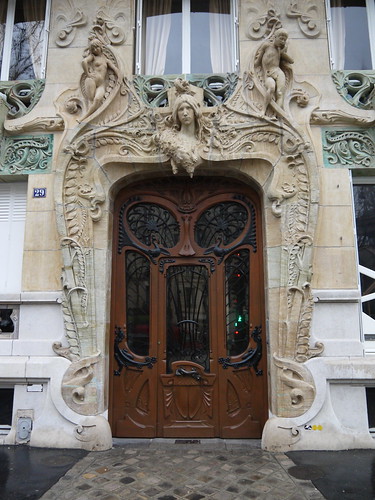
Below - facade, 29 Avenue Rapp.
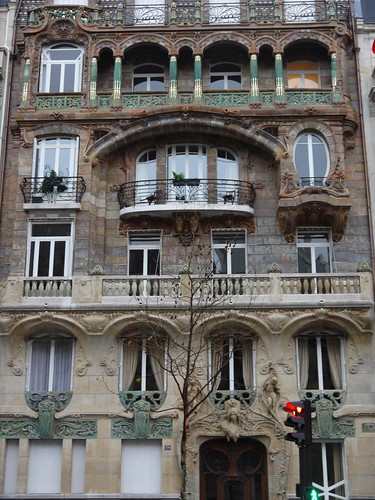
beyond fabulous dharling! JP
ReplyDeleteMerci beaucoup Mme!
ReplyDelete